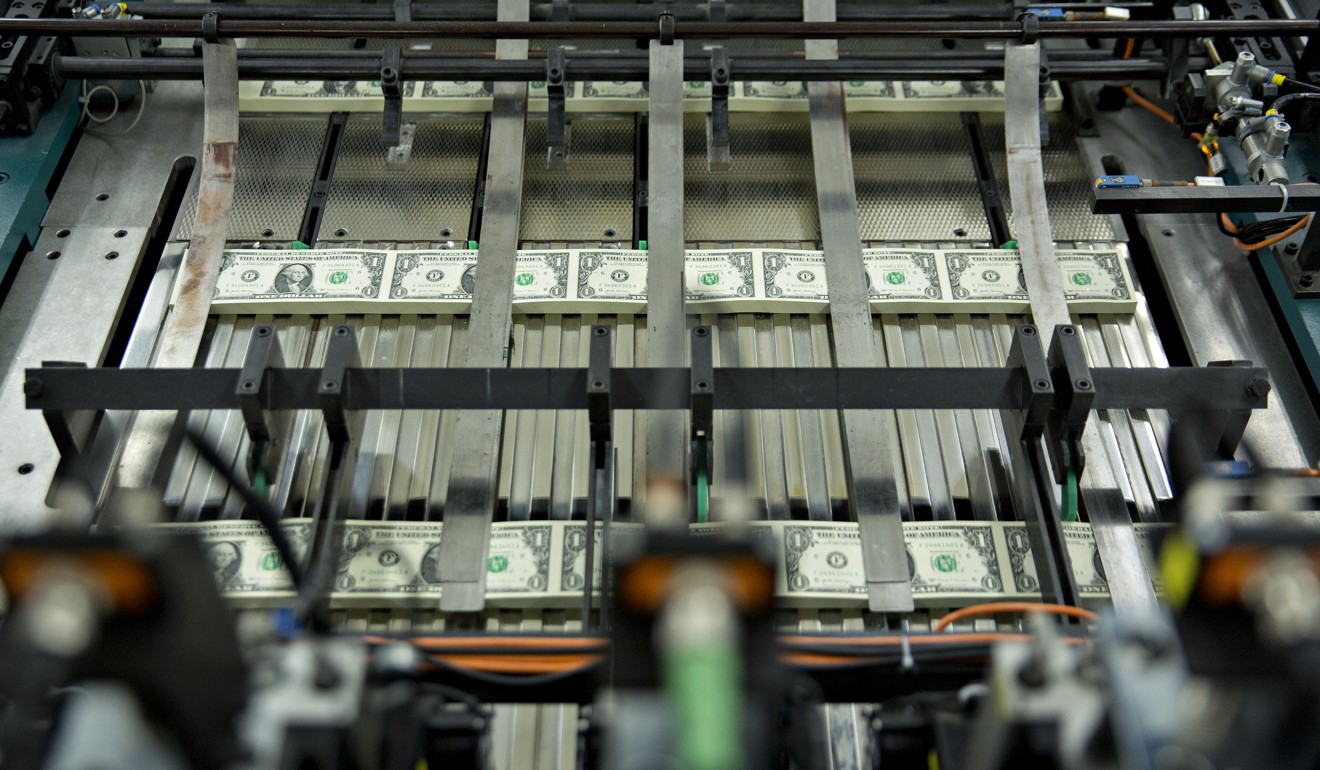
Stock meltdown: have we entered The Age of Inflation?
The slump in stock prices is far from irrational – it is based on fears that the world economy is making a once in a generation shift from disinflation to inflation. And there’s reason to believe those fears are justified
Just six weeks into 2018, the bull run in global stock markets has abruptly crashed to a halt. After a banner January, in which stock prices seemed only to go up, investors suddenly took fright. Over the first 10 days of February, stock markets around the world tumbled steeply, more than erasing all the gains they made in the first month of the year.
To add insult to injury, the sudden sell-off was triggered by what would normally be regarded as positive economic news. Many commentators took this apparent perversity as a sign of policymakers’ failure to fix a financial system that remains prone to dangerous and irrational swings a full 10 years after the outbreak of the global financial crisis.
They have a point about policymakers’ failure, especially given last week’s collapse of leveraged funds speculating on declines in market volatility.
Good news, Asia: This time, stock market flu is evenly spread
But this month’s slump in stock prices is far from irrational. Underlying investors’ nervousness is a growing fear that the world may be entering a new economic age, the like of which it has not seen for more than 35 years: an age in which inflation, rather than disinflation, is the dominant monetary force. If this fear proves to be justified – and there are reasons to believe it may be – then the sell-off of recent days is not only rational, it could well be the start of an extended period of pain for financial market investors.
One heavy hint was the immediate trigger for the stock markets’ sell-off: news that the American economy continues to create jobs at a robust rate. US employers took on 200,000 new workers in January, more than economists had expected. What’s more, US bosses are also giving their workers pay rises. Average hourly wages rose by 2.9 per cent over the 12 months to January, the fastest increase since the 2009 recession. In response, selling pressure pushed the benchmark US S&P 500 stock index down by 9 per cent over the following week, with the scare rapidly spreading around the world by contagion. In Asia, Hong Kong’s Hang Seng Index dropped 10 per cent, as did markets on the mainland.

At first glance the rout looks perplexing. Steady growth in the US is creating more jobs for American workers. With unemployment low, the resulting demand for workers is pushing up wages as bosses compete to attract and retain recruits. And more people in work coupled with higher pay means stronger demand and more consumer spending.
What could derail the global bull market in 2018?
Sure, higher wages and stronger demand could combine to push up prices. But consumer inflation remains low – barely more than 1 per cent according to the measure most favoured by Federal Reserve policymakers.
And in any case it’s not immediately obvious that a moderate rise in consumer prices should be negative for stock markets. After all, stronger demand and higher prices mean faster revenue growth for companies. And if stronger demand coupled with generous new tax breaks drive productivity-enhancing investments, that revenue growth will flow through to fatter corporate profits. All else being equal, that should push stock markets up, not down.
WATCH: How good was 2017 for stocks in Hong Kong?
The concern is that not everything else is equal. After years in which the world’s big central banks kept interest rates close to, or even below zero, in an attempt to juice up growth and avert deflation, investors are getting increasingly worried that the runaway inflationary pressure they have long feared is about to emerge with a vengeance.
There are many reasons for this, some local and short term, others global and very long term in nature. The shorter term effects will play out over the next year or two. For example, in the US the administration’s December tax cuts are likely to prove stimulative just when it appears the economy has little if any spare capacity.
Similarly in Europe, demands are growing for an end to fiscal restraint just as the euro zone economy is finally staging a vigorous cyclical upswing after its long slump. And after last week’s coalition deal in Germany, which saw the anti-austerity Social Democrats assume control of the finance ministry, long the bastion of European fiscal rectitude, those demands are set to fall on more receptive ears.
Do you still want to bet against China?
Meanwhile, production cuts among the big petroleum exporters have pushed world oil prices higher. The Japanese economy appears finally to have escaped deflation. And Beijing’s efforts to shut down excess industrial capacity have helped to ensure that China is no longer exporting deflation to the rest of the world. As a result, at a time when global demand is strong, a whole confluence of factors is suggesting that inflation pressures will mount between now and the end of the decade.
Certainly central bankers think so. In the US, the Federal Reserve is already raising interest rates and shrinking a balance sheet bloated by years of “quantitative easing” money printing. And in the euro zone, the European Central Bank recently scaled back its own money printing, as a prelude to ending it altogether later this year.

The short term effect of rising inflation expectations and less central bank money-printing has been to push down prices in government bond markets. This makes good sense: higher inflation reduces the purchasing power of the money that investors get back when bonds mature.
On top of that, investors are pricing in an increase in the net supply of government bonds. In the US, they expect more issuance from the Treasury, as the budget deficit rises following last year’s tax cuts, even as the Federal Reserve reduces its own holdings. In much the same way, European governments will continue to issue debt, while the central bank stops buying. The result will be a fall in bond prices.
These relatively short term effects are unnerving enough. But what is really spooking investors is the thought that much longer term, structural forces may be emerging that will drive global inflation and interest rates higher, not just over the course of the next few years, but of the next few decades.
Don’t panic: why Chinese stocks will continue to rise
Ever since the beginning of the 1980s, when US consumer inflation peaked at 15 per cent, both global inflation and long term interest rates have been trending downward. This disinflationary trend is partly the result of central bank policy; in the early 1980s the Federal Reserve pushed its short term policy rate up to 20 per cent to curb price rises. But as with any very long term trend, it is mainly driven by demography.
At the start of the 1980s, the US “baby boomer” generation born after the second world war started to hit their peak-earning years, even as their own children grew up. As a result, they began to spend less of their incomes and to save more. At the same time, the productive working-age populations of developing Asia began to be incorporated into the global trading system.
These demographic trends led to a deepening global pool of excess savings, which pushed long term interest rates down and asset prices up. At the same time, there were big increases in the global labour force and the international supply of consumer goods, which held down both wages and prices. The results were global disinflation and the long 35-year bull market the world has seen in both bonds and stocks.

Now these decades-old demographic trends are reversing. In the US, Europe and Japan, the baby boom generations are retiring and are drawing down their savings to fund consumption. At the same time, populations in emerging Asia are themselves ageing fast, even as they consume more of what they produce.
The result is that the excess savings glut which for years has held down long term interest rates and supported bond prices is dwindling, while at the same time the demand both for labour and for consumer goods is starting to grow relative to supply. It’s a reversal of the multi-decade trend that has prevailed since the beginning of the 1980s, and it points to higher inflation and weaker asset prices over the coming years.
Is Hong Kong’s property bubble finally ready to burst?
This reversal, in conjunction with the shorter term factors also at work, has shown up first in the US government bond market, where prices hit their all-time high in mid-2016. Since then the prices of long-dated US government bonds have fallen by around 15 per cent.
This slide in bond prices is causing trouble on several fronts, and in the past 10 days it has begun to affect world stock markets. For one thing, weaker government bond prices equate to higher long term interest rates, which strongly suggests that companies are going to face higher borrowing costs in future.

The actual impact on costs has been small so far. But in an environment in which stock market valuations look stretched, the prospect of higher borrowing costs together with rising inflation pressures is enough to make investors revise their picture of future corporate profit growth. In response, they are scaling back their holdings of more expensive “growth” stocks.
There are other factors at work, too. For example, investors have long balanced their exposure to stocks with holdings of bonds, on the assumption that in the short term the prices of the two assets were inversely correlated. That made sense in an environment of disinflation. But in an age of inflation, bonds are no longer an effective volatility-reducing hedge for equity investors. As a result, investors are increasingly rethinking the whole structure of their portfolios.
Why the Hong Kong bull market is set to run and run
The result is the doubt and uncertainty that has afflicted financial markets this month. The alarm may yet prove premature.
The world is a long way from experiencing the double-digit inflation rates of the late 1970s and early 1980s. And there are good reasons to believe that the run-up in Asian stock markets, and in Hong Kong-listed shares in particular, may not yet be over.
But for ordinary savers nervous at the prospect that the world economy may be making a once in a generation shift from disinflation to inflation, it may be time to think about inflation-proofing their portfolios. Looking back at the lessons of the inflationary 1970s, when US stocks rose by 190 per cent, while the price of gold rose 1,500 per cent, it may be time to hedge exposure to the stock market by buying a little of the yellow metal – just in case. ■
Tom Holland is a former SCMP staffer, who has been writing about Asian affairs for more than 20 years

